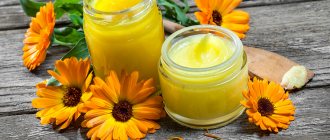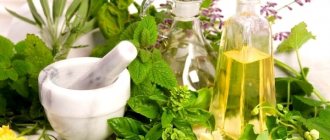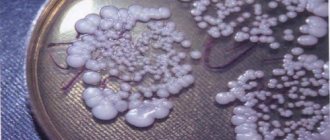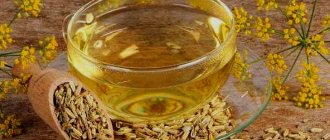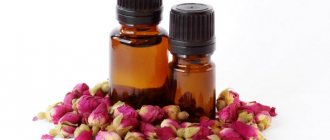Home » Traditional recipes
Folk recipes
Author Maria Khorolets Reading time 9 min. Views 697 Published 02/22/2016
Crohn's disease can occur in both young and older people. It is chronic in nature, so it is quite difficult to treat. However, it is possible to relieve the symptoms of the disease and prevent further deterioration of the patient’s condition. Reliable methods of traditional medicine, proven natural remedies and a special diet will help you with this.
- Ways to get rid of Crohn's disease using folk remedies
Infusions and decoctions - Plants' seeds
- Oils
- Other treatments
- Basic Rules
Possible causes of the disease
Experts believe that the main reason for the development of the disease is a genetic predisposition, manifested by disturbances in the functioning of the immune system. Scientists name several versions explaining the reasons that trigger the pathological mechanism. Virologists talk about the measles virus, infectious disease specialists talk about a tuberculosis infection or an unidentified one.
Relatively recently, a theory has emerged that explains the development of autoimmune intestinal diseases - this is its unnatural sterility. Each person should normally have a certain number of helminths under the control of the immune system. In recent years, complete deworming has become common. According to this theory, in the vacated niche, the body’s own body comes under the influence of the immune system.
Let us remind you once again that these are just theories, and the exact causes of the disease have not yet been established.
Symptoms of the disease
As a rule, the pathological process develops in the ileum. Then it moves to other parts of the gastrointestinal tract. Common symptoms of the disease include:
- significant and sudden weight loss;
- changes in the skin (decreased tone, dryness);
- weakness;
- fever.
The disease is often accompanied by inflammation of the eyes and blood vessels, joint pain, osteoporosis, amyloidosis, and a high level of blood clotting. Local symptoms occur at the location of the pathology. During endoscopic examination, the affected area appears covered with deep and narrow ulcers, the mucous membrane has an uncharacteristic color.
The pain is most often localized on the right in the lower abdomen of a cramping nature, often reminiscent of the clinical picture of appendicitis. The patient suffers from diarrhea mixed with blood up to 10 times a day. Treatment with folk remedies will help eliminate intestinal inflammation and ease the symptoms of Crohn's disease. These can be infusions and decoctions, oils and other effective remedies, the recipes of which are kept by traditional healers.
Symptoms of Crohn's disease
Symptoms of Crohn's disease can be divided into several groups:
- General symptoms: fatigue and weakness, fever, bone loss.
- Intestinal symptoms: abdominal pain and intestinal cramps, nausea, vomiting, weight loss, vitamin deficiencies, etc.
- Extraintestinal symptoms: damage to the oral mucosa (“aphthous stomatitis”, Fig. 4), eyes (conjunctivitis, etc.), skin. Occurs in approximately 12% of cases.
- Symptoms of complications that have begun.
Figure 4. Aphthous stomatitis sometimes becomes the only manifestation of Crohn's disease.
Source: jorgecachoh/Depositphotos Depending on the location of the lesion, symptoms can be combined in different ways (Table 1).
Table 1. Symptoms of Crohn's disease with lesions of various locations.
| Form of the disease | Localization of the lesion | Symptoms | Frequency |
| Ileocolitis | Ileum+right flank of colon | Diarrhea, abdominal pain, intestinal cramps, weight loss | 42% |
| Ileitis | Ileum | Diarrhea, abdominal pain, intestinal cramps, weight loss | 33% |
| Colitis | Colon | Diarrhea, rectal bleeding, formation of abscesses, fistulas and rectal ulcers | 20% |
| Other forms | A combination of various areas involving the stomach, duodenum, anal area, etc. | Anorexia, weight loss, nausea, vomiting. | 5% |
Symptoms in children
In children, there is a predominance of extraintestinal symptoms over intestinal ones. So, the disease at first may manifest itself:
- joint pain,
- anemia,
- hypovitaminosis,
- a rise in temperature for no apparent reason (the so-called “fever of unknown origin”),
- growth retardation and weight loss.
Diarrhea and abdominal pain may be absent.
Sage
The plant, well known to many, has analgesic, disinfectant and anti-inflammatory properties. Because of this, sage is often used in the treatment and prevention of gastrointestinal diseases. To prepare an infusion of sage, pour 0.2 liters of hot water into a tablespoon (tablespoon) of dry raw materials and leave for an hour. The strained mixture is taken ½ cup three times a day.
It is easy to prepare a decoction from this plant. To do this, you need to pour a tablespoon of raw material with a glass of boiling water and place the container with the mixture on low heat for 10 minutes. After this, turn off the heat and let the product brew under a closed lid for half an hour. Take the filtered decoction three times a day, one tablespoon (tablespoon).
Infusions
Recipe No. 1. Mix equal parts of cumin fruits, peppermint, chamomile flowers and valerian roots. Pour boiling water (300 ml) into one spoon (tablespoon) of the herbal mixture and let it brew for an hour. After this, the remedy should be filtered and taken in the morning, afternoon and before bedtime, ½ cup.
Recipe No. 2. When treating Crohn's disease with folk remedies, herbs are often used. The following remedy is prepared from mint, yarrow, sage and chamomile. Judging by patient reviews, this infusion effectively relieves intestinal colic and flatulence. All ingredients should be taken in equal parts and mixed. Pour boiling water (200 ml) into a teaspoon of the mixture. The infusion should be covered until it cools. Then it must be strained and consumed during the day in four doses.
Recipe No. 3. This infusion has proven itself well in the long-term treatment of Crohn's disease. It is recommended to purchase herbs for folk remedies at a pharmacy. This composition will help relieve intestinal inflammation and get rid of pain. You will need:
- sage;
- centaury;
- chamomile.
Herbs are taken in equal parts, usually a teaspoon. The collection is poured into 0.2 liters of boiling water and infused. The finished product is taken up to 8 times a day, one tablespoon at a time. After three months, the dosage is reduced to a teaspoon, and the intake is reduced to three times a day. This course can be continued for another three months, then take a break for a month, after which treatment can be resumed.
Is it possible to treat Crohn's disease using traditional methods?
Crohn's disease responds well to treatment using traditional methods, especially if they complement drug treatment.
- Onions have healing properties; there have even been cases of complete recovery from cancer with the peel of this vegetable. When preparing dishes, you need to throw the onion in the peel into water and remove it before eating.
- Sage has a positive effect. It has an analgesic effect, removes pus and relieves inflammation. Prepare a decoction of 200 ml of boiling water and a couple of tablespoons of herbs. The decoction is infused for an hour. Take 5 times a day, 150 ml per dose.
- Young sunflower heads – chop 200 grams and pour 0.5 liters of vodka. Infuse in a covered glass container for 8 days. Dilute 1 teaspoon of solution in 150 ml of water, take twice a day before breakfast and dinner.
- Sea buckthorn oil has a healing effect; you need to take 60 ml on an empty stomach 3 hours before meals.
- Bolotov’s sourdough, which is prepared using celandine, has helped many. To prepare, you will need 2 liters of whey, a glass of sugar and the same amount of crushed fresh or dry celandine, season everything with a tablespoon of sour cream. You need to leave the mixture for 2 weeks and remove any mold that appears.
- Flax oil protects against food damage to the walls of the stomach and intestines.
- Rosehip oil can be prepared at home: chop the fruit, fill a liter jar up to the neck and add olive oil. Infuse in a warm place for 12 days.
In addition, you can drink an infusion of chamomile, which has an anti-inflammatory and wound-healing effect.
Oils
Vegetable oils are very effective in treating Crohn's disease with folk remedies. The leading position among them is occupied by sea buckthorn oil. You should buy it at a pharmacy to avoid purchasing counterfeit products. Take sea buckthorn oil daily on an empty stomach, 50 ml two hours before meals. Treatment continues without interruption until the condition improves.
Reviews
Despite the fact that Crohn's disease is not so common, you can find many reviews about the effective treatment of this pathology with folk remedies.
Irina Prolonged discomfort in the intestines, frequent diarrhea and flatulence forced me to see a doctor. After examination, I was diagnosed with Crohn's disease. They said there was no special treatment. It is necessary to follow a diet and take medications to relieve symptoms. But one traditional medicine specialist advised me to try medicinal herbal teas. He drew up a treatment plan for me. First I drank a mixture of chamomile, sage, mint and yarrow, then - from chamomile, mint, valerian, caraway fruits. Then I took several more different collections with short breaks. Now I hardly take any medications because I feel good, although I still have to follow a diet.
Sergey I was diagnosed with Crohn's disease in my teens. He was treated for a long time and unsuccessfully with medications, until he went to his grandmother for the summer. She brewed me various herbs according to her recipes. I only remembered that she made medicine from onion skins. She made me drink it all. And now I have a long-term remission, only when I deviate from the diet, I have to take medications again.
Igor My Crohn's disease was severe. I had to take medicine constantly. I also tried traditional methods, but I can’t say what exactly helped me. Now I have exacerbations less often, but I don’t refuse medications, I’m afraid of worsening.
Treatment of Crohn's disease with traditional methods can significantly improve the patient's condition and reduce the amount of medications taken. But they should only be used as part of complex therapy as prescribed by a doctor.
Rosehip oil
This oil can be made at home yourself. To do this, you will need a full liter jar of fresh fruit. They are poured in portions onto a cutting board and crushed with a rolling pin. Then the mashed fruits are poured into a two-liter glass jar and the raw materials are filled with 1.5 liters of vegetable oil. The mixture is stirred, tightly closed with a lid and the container is placed in a dark place for two weeks. Then the oil should be filtered and taken by spoon (tablespoon) three times a day according to the following scheme: on an empty stomach, an hour before breakfast, an hour before lunch and two hours after dinner.
Symptoms
Clinical signs of Crohn's disease can vary. It depends on the stage and location of the inflammation. The defeat of the gastrointestinal tract always comes to the fore.
But a disturbance in the activity of the immune system can provoke the development of inflammation of other systems and organs. The following signs are distinguished:
- bleeding;
- constipation;
- diarrhea;
- vomit;
- colic in the abdomen;
- extraintestinal manifestations of the disease.
The severity of all symptoms depends on the location of the inflammatory process and its neglect.
Characteristics of bleeding in Crohn's disease
Statistics show that in 95% of patients the inflammatory process occurs in the large and small intestines. The appearance of blood in the stool can be explained by the fact that the ulcerative process progresses and spreads to the deep layers of the intestinal walls, where the blood vessels are damaged.
The nature and amount of blood released depends on the depth, size and level of the inflammatory process, which can be:
- Aloy. Bleeding occurred in the area of the final sections of the colon or rectum. Almost ready-made feces are located here, so the blood does not mix with them, but is located on them.
- Dark scarlet. Bleeding occurs in the initial parts of the large intestine, where feces have not yet formed. So, the blood mixes with the feces, which gives the dark color.
- Black with a smell. Bleeding originates in parts of the small intestine, where, under normal environment and conditions, incoming food is absorbed and digested. Blood cells are destroyed by digestive enzymes. The contents are mixed with remaining food, which is the reason for the black color.
We recommend reading: Symptoms of pancreatic disease and treatment of inflammation at home
At the initial stage, damage to blood vessels is minor. In some cases, the presence of blood in the stool cannot be noticed independently, only with additional research. In other cases, the patient may observe small blood streaks, which will be the first signal to see a doctor.
Heavy bleeding with this disease can occur only in advanced cases. It must be remembered that the presence of blood in the stool is not normal, so if abnormalities are detected, you should immediately go to the doctor.
Characteristics of diarrhea
Most people with Crohn's disease suffer from diarrhea. This process occurs due to the presence of inflammation in the intestinal wall. The inflammation that occurs in this area irritates the nerve endings. This helps speed up the passage of food through the digestive tract, thereby reducing the level of absorption and digestion, which causes diarrhea.
Stool can appear up to 10 times a day. Between bowel movements, false urges may appear, accompanied by colic in the abdomen. The urge may be accompanied by the release of mucus and blood in small quantities, and feces may be almost completely absent.
Constipation
Constipation is a rare symptom, unlike diarrhea. Occurs in approximately 20 patients out of 100, and usually alternates with diarrhea. Constipation is explained by irritation of the nerve endings, which leads to spasm. Feces accumulate in front of the spasmodic area, stretching and overflowing the intestinal loops. The intestinal walls become tense, which can be seen with the naked eye when palpating the abdomen.
Constipation is often accompanied by painful and frequent false urge to defecate. Violation of bowel movements can lead to serious complications, so going to the hospital is inevitable.
Vomiting and nausea
If inflammation develops in the stomach or intestines, nausea and even vomiting may occur.
In this case, the enzymatic and mechanical processing of incoming food is disrupted, and the digestion process slows down.
Vomiting may occur due to blood entering the intestines or damage to blood vessels. This provokes overflow of the intestinal loops and the launch of certain reflex mechanisms.
Pathological conditions may occur in which the direction of food movement changes. The contents of the stomach come out due to a sharp contraction of the muscles of the abdominal wall and respiratory tract. Vomiting in the presence of this disease is rare, usually due to poor diet.
Colic in the stomach
Colic is paroxysmal in nature, it can be either pulling or stabbing. The pain ranges from mild to unbearable. If the stomach is affected, the pain will be felt in the upper abdomen. When the transition from the small to the large intestine is affected, the pain is located in the lower right corner.
If inflammation has formed in the area of the small intestine, spasms will occur near the navel. Pain in the lower abdomen indicates inflammation in the large intestine.
We recommend reading: Liver cyst - what it is, symptoms of the disease and treatment at home
Extraintestinal signs
The disease also manifests itself outside the intestines, usually due to untimely treatment.
The following symptoms are identified:
- heat;
- joint damage;
- skin rashes;
- eye diseases;
- kidney and liver damage;
- sudden weight loss and anemia.
In addition, the patient may become irritated, his appetite worsens and his sleep is disturbed. The quality of life is greatly affected.
Patient reviews
Treatment of Crohn's disease with folk remedies, according to reviews from patients and doctors, is impossible without the use of medications, however, using the above recipes, you can alleviate the condition and relieve the symptoms of the disease. Their effective use is only possible in combination with traditional methods and means prescribed by the attending physician. This disease does not forgive self-medication, so any means must be agreed with a specialist, and their use should be carried out under his supervision.
The benefits and harms of treatment with folk remedies
Treatment of Crohn's disease with folk remedies should be carried out with great caution and always under the supervision of a specialist. Herbal infusions, decoctions, ointments and other remedies will help you get rid of increased gas formation, bloating, relieve inflammation and severe pain. Compared to medications, folk remedies contain fewer toxins, have a more beneficial effect on the body and have minor side effects. At the same time, herbal treatment, if you take medicines prepared from them uncontrollably and at random, can cause irreparable harm. Some plants contain natural poisons, others are strong allergens, and others are dangerous in case of overdose.
